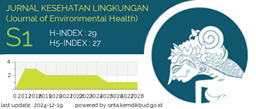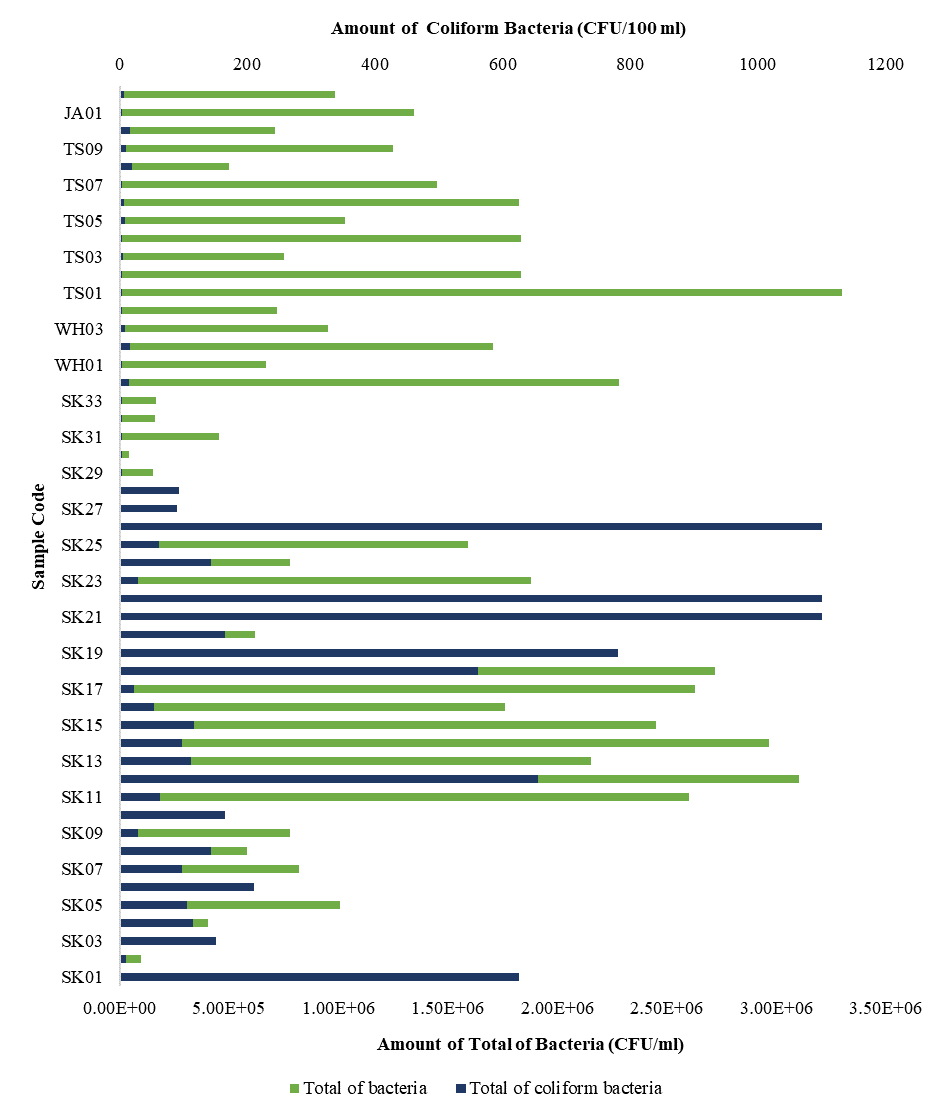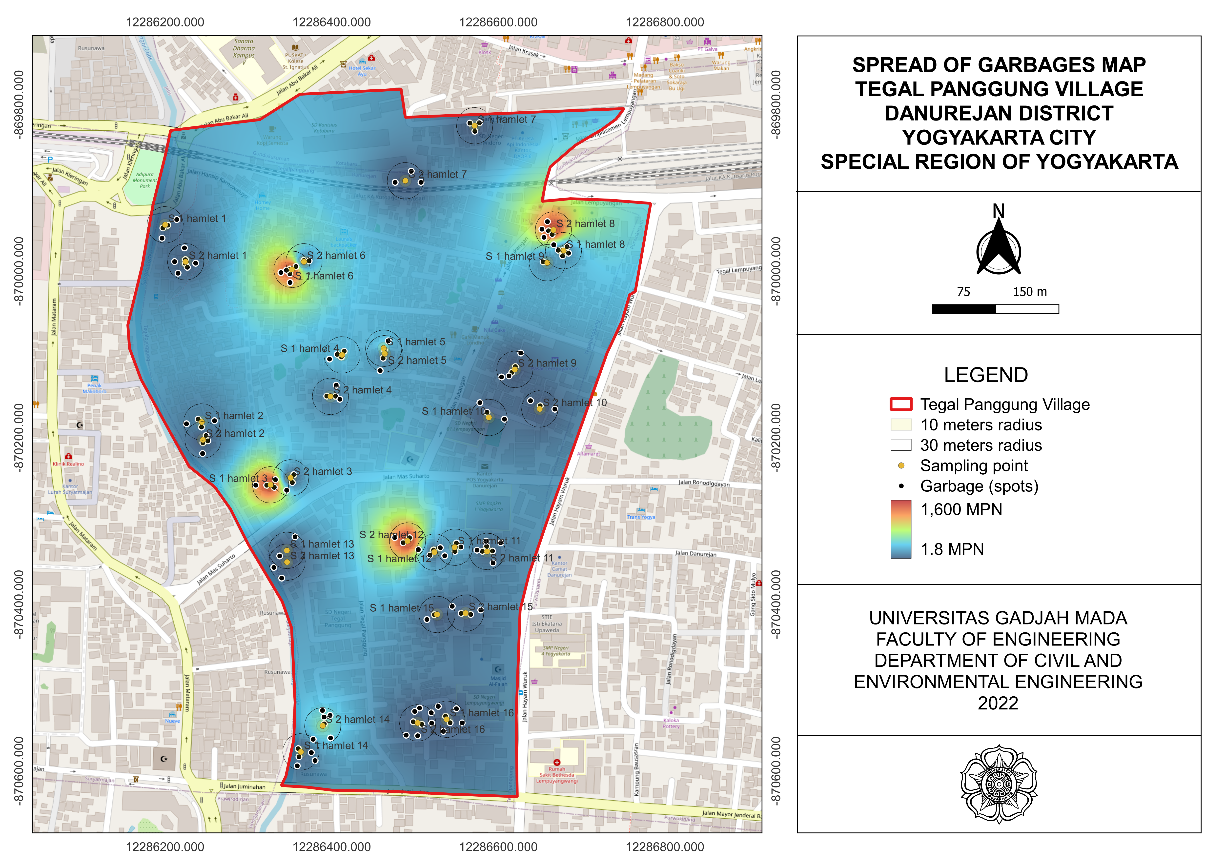The Physical and Chemical Air Quality, Worker's Characteristics, and Respiratory Symptoms Among Printing Workers in Surabaya
Downloads
Abstract: Printing industry is an industry which in its production process generate air pollutants such as Particulate Matter (PM). The exceeds limit of PM2,5 can cause respiratory symptoms, cardiovascular disease, and pulmonary function disorder. The objective of this study was to analyze physical and chemical air quality and respiratory symptoms among printing industry workers in Surabaya. It was observational study with cross sectional approach and analyzed descriptively. The physical and chemical air quality was measured by Thermohygrometer and Haz Dust EPAM 5000 at three different areas in production unit. Worker's characteristics and respiratory symptoms were obtained from 20 respondent's questionnaires. The highest concentration of PM2,5 level was at cutting room (area 1), which maximum concentration was 20.0 μg/m3 and the average was 6.1 μg/m3. The result showed that PM2,5 levels was below threshold limit value. It is suggested to printing industry to improve administrative control application by managing work period and useing mask, to clean ventilation, dust collector, or production facilities and to examine health status regularly to public health center for workers at printing industry.
Keywords: physical and chemical air quality, printing industry, respiratory symptoms
Alfi ah, T. 2009. Pencemaran Udara Teknik Lingkungan.
Surabaya: Teknik Lingkungan ITATS.
Badan Pusat Statistik. 2015. Surabaya dalam Angka 2014.
Dipetik February 2, 2016 dari http://surabayakota.
bps.go.id/website/pdf_publikasi/Surabaya-Dalamangka-
Badan Pusat Statistik. 2015. Surabaya Dalam Angka
Dipetik February 2, 2016, http://surabayakota.
bps.go.id/website/pdf_publikasi/Surabaya-Dalamangka-
Badan Standarisasi Nasional. 2001. SNI 03-6572-
Tata Cara Perancangan Sistem Ventilasi dan
Pengkondisian Udara pada Bangunan Gedung.
Jakarta.
BBTKL dan PPM. 2009. Situasii Kecenderungan
Parameter Pencemar Lingkungan dan Risiko
Gangguan Kesehatan di Kota Surabaya Tahun
–2008. Laporan. Surabaya.
Colorado Department of Public Health and Environment.
A Guide to Environmental Regulations for:
Printing & Imaging Facilities. Dipetik January 12,
, darii rado.gov/pacifi c/sites/default/fi les/AP_
Guide-to-Environmental-Regulations-for-Printingand-
Imaging-Facilities_1.pdf
Danusantoso, H. 2000. Buku Saku Ilmu Penyakit Paru.
Jakarta: Hipokrates.
Departemen Kesehatan. 2009. Pedoman Pengendalian
Penyakit ISPA. Dipetik Desember 18, 2015 dari
id.scribd.com/mobile/doc/21879326.
Departemen Kesehatan. 2013. Parameter Pencemaran
Udara dan Dampaknya Bagi Kesehatan. Dipetik
December 14, 2015 dari http://www.depkes.go.id/
downloads/udara.pdf
Ekowati, R. 2012. Analisis Risiko Paparan Debu (Linen
Dust) terhadap Gangguan Fungsi Paru. Universitas
Airlangga. Thesis. Surabaya: Universitas Airlangga
EPA. 2014. Particulate Matter. Dipetik January 5, 2016
Groover, M.P. 2007. Fundamental of Modern
Manufacturing: Materials, Processes, and Systems,
rd Edition, John Wiley & Sons, New York.
Hariadi, S., Amin, M., Wibisono, M.J., Hasan, H. 2008.
Dasar-dasar Diagnostik Fisik Paru. Surabaya:
Laboratorium Ilmu Penyakit Paru, Fakultas Kedokteran
Universitas Airlangga.
Kementerian Kesehatan RI. 2002. Keputusan Menteri
Kesehatan Nomor 1405/MENKES/XI/2002 tentang
Persyaratan Kesehatan Lingkungan Kerja Perkantoran
dan Industri.
Kementerian Kesehatan RI. 2002. Keputusan Menteri
Kesehatan Republik Indonesia Nomor 1407/MENKES/
SK/XI/2002 tentang Pedoman Pengendalian Dampak
Pencemaran Udara.
Kementerian Kesehatan RI. 2004. Parameter Udara dan
Dampaknya terhadap Kesehatan. Dipetik Januari
, 2016 dari http://www.depkes.go.id/downloads/
Udara.pdf
Mukono, J. 2003. Pencemaran Udara dan Pengaruhnya
terhadap Gangguan Saluran Pernapasan. Cetakan
kedua. Surabaya: Airlangga University Press.
Mukono, J. 2008a. Pencemaran Udara dan Pengaruhnya
terhadap Gangguan Saluran Pernapasan. Surabaya:
Airlangga University Press.
Oktaviani, D.A. 2016. Analisis Kadar PM2,5 dan keluhan
Pernapasan Pada Pekerja Percetakan di CV Bayu
Mandiri. Thesis. Universitas Airlangga. Surabaya.
Okwari, P.O. 2005. Lung Function Status of Workers
Exposed to Wood Dust in Timber Markets in Calabar,
Nigeria. African Journal of Medicine And Medical
Sciences. 2(34): 141–5.
Puslitbang Keselamatan Radiasi dan Biomedika Nuklir
(P3KRBiN). 2004. Perkiraan Deposisi Partikel Udara
(PM10/PM2,5 dan TSP) pada Saluran Pernapasan
Penduduk Cilegon Menggunakan Perangkat Lunak
Ludep. BATAN. Dipetik February 25, 2016 dari http://
digilib.batan.go.id/e-prosiding/File%20Prosiding/
Energi/Pros_LitNuklir_2008/Data/Sumiardjo_245.
Putri, E.P. 2012. Konsentrasi PM2,5 di Udara dalam Ruang
dan Penurunan Fungsi Paru pada Orang Dewasa di
Sekitar Kawasan Industri Pulo Gadung Jakarta Timur
Tahun 2012. Universitas Indonesia. Skripsi. Depok:
Universitas Indonesia.
Pranowowati, P., Maryanto, S. 2010. Induksi Partikel
Terhirup dalam Asap Terhadap Kapasitas Fungsi
Paru pada Pengrajin Pengasapan Ikan di Kelurahan Bandarharjo Kecamatan Semarang Utara Kota
Semarang. Jurnal Gizi dan Kesehatan. 2(1): Januari
: 10–11.
Qian, Z., Molin, H.Q., Kong, H., Bentley, L.C., Liu,
W. 2008. High Temperatures Enhanced Accute
Mortality Effects of Ambient Particle Pollution in the
"Oven” City of Wuhan, China. Environmental Health
Perspectives 116(9).
Rahardjo, R.A. 2012. Hubungan Antara Paparan Debu
Padi Dengan Kapasitas Fungsi Paru Tenaga Kerja di
Penggilingan Padi Anggraini, Sragen, Jawa Tengah.
Universitas Sebelas Maret. Skripsi. Surakarta:
Universitas Sebelas Maret.
Santiasih, I. 2012. Paparan Partikulat (PM10 dan PM2,5)
Terhadap Tenaga Kerja di Dalam Ruangan. Paper
and Presentation of Environment.
Engineering. Dipetik January 17, 2016 dari http://digilib.
its.ac.id/public/ITS-Master-29011-3310201006-
abstract-id-santiasih.pdf
Salisa, S.S. 2011. Paparan Asap dari Aktivitas Pengasapan
Ikan Terhadap Keluhan Mata, Pernapasan, dan Fungsi
Paru (Studi di Jalan Kejawan Lor Kelurahan Kenjeran,
Kecamatan Bulak, Surabaya). Universitas Airlangga.
Skripsi. Surabaya: Universitas Airlangga.
Sholikhah, A.M. 2015. Hubungan Karakteristik Pekerja
dan Kadar Debu Total Dengan Keluhan Pernapasan
Pada Pekerja Industri Kayu X di Kabupaten Lumajang.
Jurnal Kesehatan Lingkungan. 1(1): 1–12.
Sugiarti. 2009. Gas Pencemar dan Pengaruhnya Bagi
Kesehatan Manusia. Fakultas Matematika dan Ilmu
Pengetahuan Alam Universitas Negeri Makassar.
Jurnal Chemical. 10(1).
Suma'mur, P.K. 2009. Higiene Perusahaan dan Kesehatan
Kerja (Hiperkes). Jakarta: Sagung Seto.
Suryanta, N. 2009. Pengaruh Pengendalian Paparan
Debu pada Pekerja Pensortiran Daun Tembakau
di PT. XX Kabupaten Deli Serdang. Universitas
Sumatera Utara. Skripsi. Medan: Universitas
Sumatera Utara.
Wardhana, W.A. 2007. Dampak Pencemaran Lingkungan
(edisi revisi). Edisi III. Yogyakarta: Andi offset
–127.
2. Formal legal provisions to access digital articles of electronic journal are subject to the provision of the Creative Commons Attribution-ShareAlike license (CC BY-NC-SA), which means that Jurnal Kesehatan Lingkungan is rightful to keep, transfer media/format, manage in the form of databases, maintain, and publish articles.
3. Published manuscripts both printed and electronic are open access for educational, research, and library purposes. Additionally, the editorial board is not responsible for any violations of copyright law.
JKESLING by UNAIR is licensed under a Creative Commons Attribution-ShareAlike 4.0 International License.







































